Halkidiki, Greece, is the most popular beach and resort area in Northern Greece. With silky white sands and jewel-toned waters, Halkidiki’s beaches are as lovely as those of the Greek Islands. Also sometimes called Chalkidiki, this is a large and complex region with a lot to offer. Here is a travel guide to help you find the ideal Halkidiki experience for you, including where to stay, and interesting and unexpected things to do.
Halkidiki is less than an hour from Thessaloniki. Famous for its lifestyle and nightlife, this is an excellent city break destination. Thessaloniki is full of diverse cultural attractions and UNESCO World Heritage monuments. It makes a great addition to a Halkidiki holiday.
Related post: Best Things to do in Thessaloniki – Sights, Activities, and Cultural Experiences
Exploring Halkidiki
The landscape of Halkidiki is lush, with thick pine forests edging the pristine beaches. It’s also varied. Besides the world-famous beaches, there are beautiful mountainous regions, and cliff-top villages with views.
Three of us from Travel Bloggers Greece were on a recent trip to Halkidiki with Pass Partout, exploring the urban centers of Northern Greece, where we also discovered the Pella Region and Edessa. On our trip to Halkidiki, we found that this famous destination offers much more than beaches. Moreover, Halkidki is an inviting destination in any season.
Where is Halkidiki?
Halkidiki, a large peninsula just east of Thessaloniki, is one of Greece’s most interesting and popular destinations. It’s very close to the Thessaloniki Makedonia Airport/SKG. But it feels like a remote, exotic island.
How to Get to Halkidiki
It’s also very easy to get to. Many destinations in Halkidiki are only half an hour from Thessaloniki’s Makedonia Airport. Here are simple directions on how to reach Halkidiki by public transportation. It’s also fun to explore by car.
The Geography of Halkidiki
This complex peninsula is divided into distinctive sections, each with its own character. Imagine a fist with three fingers extended. Because of its complex geography, Halkidiki has 500 km of coastline. That means a lot of beaches, and very lovely ones.
Central Halkidiki
The fist is Central Halkidiki, with the green Mt. Holomondas at its center. The capital of the region – Polygyros – is in Central Halkidiki. There are also many charming villages with traditional stone architecture. The forested land is thick with pines and a variety of other trees. This is beautiful countryside, rich with honey and rustic cuisine.
Kassandra
The first “leg” is the one closest to Thessaloniki. This is Kassandra. It’s about 35 kilometers long, and a less than 10 kilometers wide at its widest point. It’s easy drive all around the leg in one day. Kassandra, Halkidiki is only about 45 minutes from Thessaloniki.
Sithonia
The middle leg is Sithonia. It’s a little larger than Kassandra, and a little wilder and more remote feeling.
Mt. Athos
The third leg is perhaps the most famous – Athos. Also called Mt. Athos, this extraordinary area is a UNESCO World Heritage site, with over 20 monasteries, some over a thousand years old. There is also an actual mountain. At the very tip of the leg is the 2033. Mt. Athos.
Eastern Halkidiki
The East Coast of Halkidiki faces the island Thassos and lots of open sea, making for pure waters. This quieter edge of Halkidiki has an extraordinary archaeological site – Ancient Stagira, the city of the philosopher Aristotle.
Kassandra, Halkidiki – What to See and Do
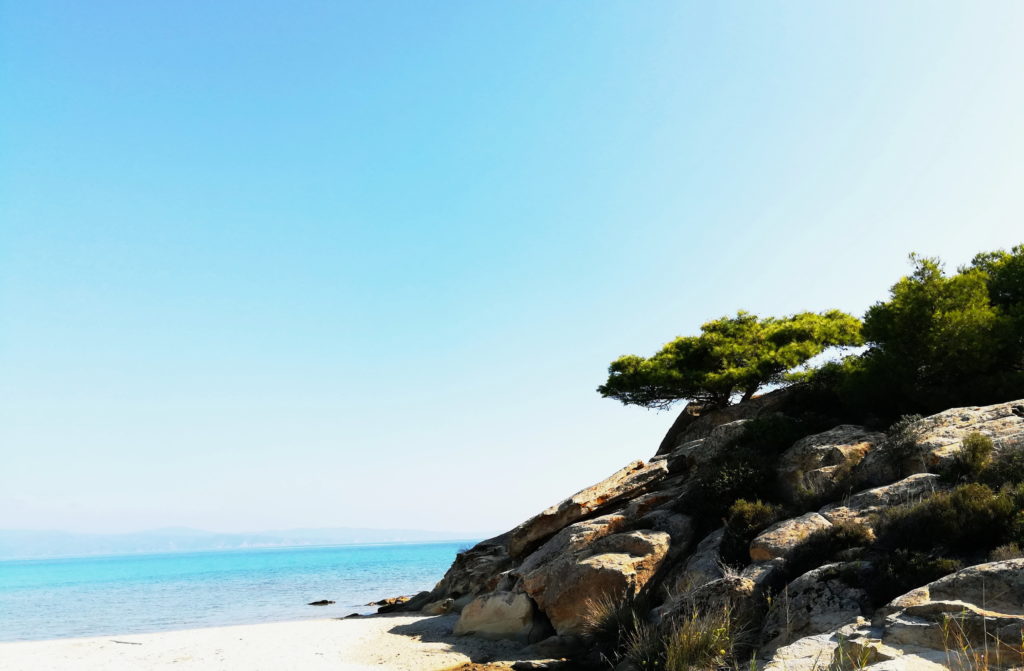
The first leg of Chalkidiki is for many the most popular. It’s a quick trip from Thessaloniki. Kassandra is also more developed than Sithonia. This is the leg with the most and liveliest beach bars and nightlife. But there is still plenty of unspoiled nature, as well as unexpected history.
Nea Potidea
There’s also culture and history. Our first stop was in Nea Potidea, at the very top of Kassandra. Potidea takes its name from Poseidon, patron god of the seafaring Corinthians who colonized it in the 7th century BC.
Kassandra, in turn, was named by Cassander – this is the same king who founded Thessaloniki and named it after his wife – Thessaloniki. The bays of Thermaikos (the Thessaloniki side) and Toronoeos (the side facing Sithonia) can be controlled from here.
The Potidea Canal
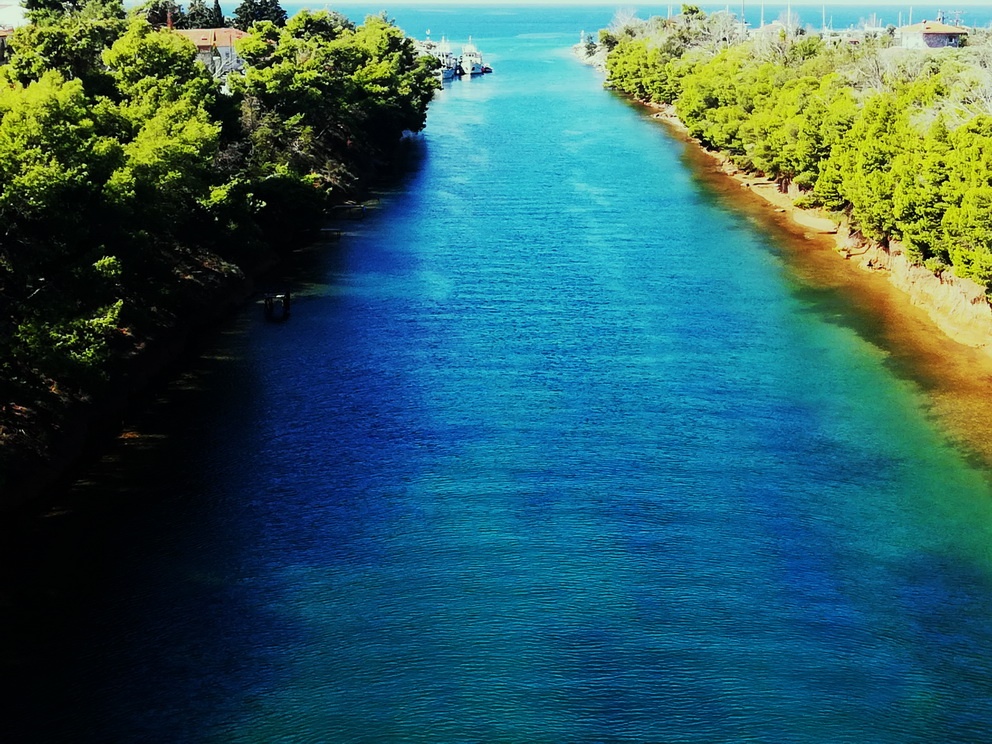
Kassandra is attached to the main peninsula by a narrow strip of land, just over a kilometer wide. Likely during the reign of Cassander, a canal was cut through this narrow strip of land, connecting the Bay of Termaikos with the Bay of Toroneos. The Potidea canal renders Kassandra technically an island. Boats are always passing through, saving great distance it would take to navigate around the whole of the leg.
Nea (“new”) Potidea was the name that the refugees from Asia Minor gave the area when they settled here in the 1920s.
Nea Fokea
The beach town Nea Fokea is just over ten kilometers from Nea Potidea. A tall Byzantine tower overlooks the town’s charming marina and beach. As in Potidea, the Nea in the name means new – given by refugees from Asia Minor who settled here.
The Spring of St. Paul in Fokea
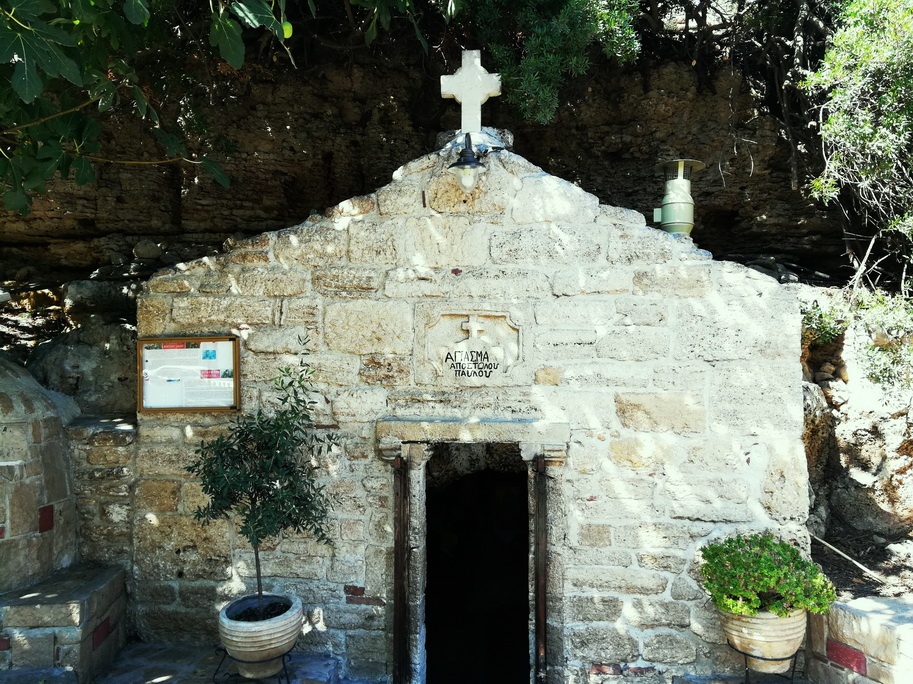
Besides the Byzantine Tower of Fokea, built in 1407, there’s an even more interesting site – the Spring of St. Paul. It’s just across the road from the Byzantine Tower – on your right as you drive south down the leg.
St. Paul took refuge in this cave when being chased by pagans. In one version, the cave opened up before him as he sought safety. A spring of holy water flowed in the cave, and he used it to baptize new Christians. This has been a holy place since the earliest years of Christianity. Where the water flows, you’ll see traces of religious wall paintings.
The entrance to the spring looks like a small church built into the rock. Descending through a narrow doorway, you’ll see the entrance to a tunnel. With a low ceiling, the narrow 20-meter tunnel is not for everyone. But those who do go should take the scoop attached to a rope – somewhere at the entrance to the tunnel. The water is too far down for your hand to reach.
Athitos
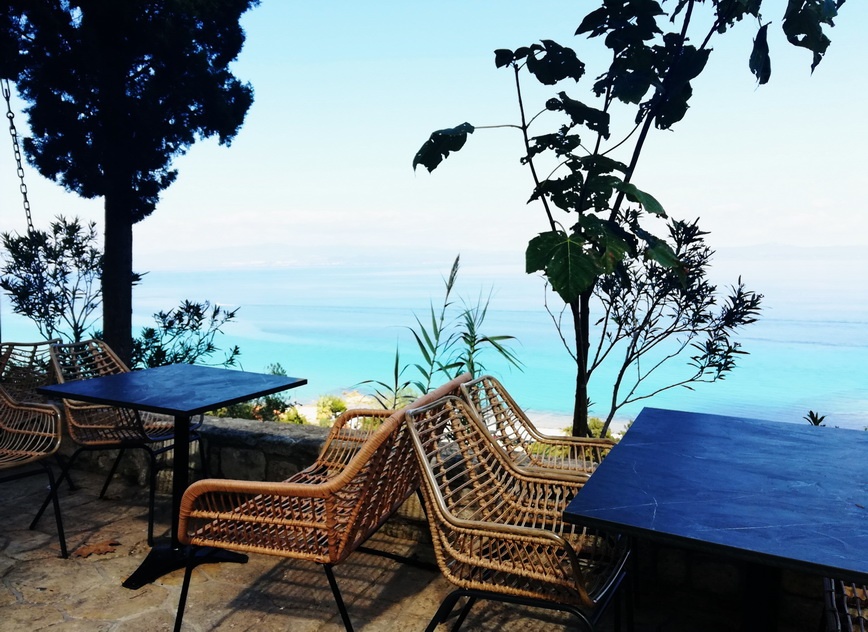
Athitos – sometimes called Afitos – is built on the edge of a cliff, 75 m above the Toroneos gulf. The views, of course, are fantastic, and so are the cooling breezes. Traditional stone buildings line the streets of the town, where you’ll find shops with hand-crafted gifts, classic tavernas and ouzeries, and modern cafe/bars. If you want the beach, a soft sand beach is right at the base of the cliff. This is a good choice for charming hotels with sweeping views.

We had a fantastic lunch of octopus carpaccio and other fresh seafood pleasures at Tuna, in the Rigas hotel. We were on a veranda with an endless view of the gulf of Toroni.
Kryopigi
Just south of Athitos is another village with an authentic character and beautiful architecture. This hillside town edges a silky white beach. And it’s a fantastic beach, with a blue flag for the quality of the waters, beach, and environmentally conscious upkeep. Like so much of Halkidiki, Kryopigi is wonderfully green, fresh with the scent of pine on the breezes.
Agia Pareskevi
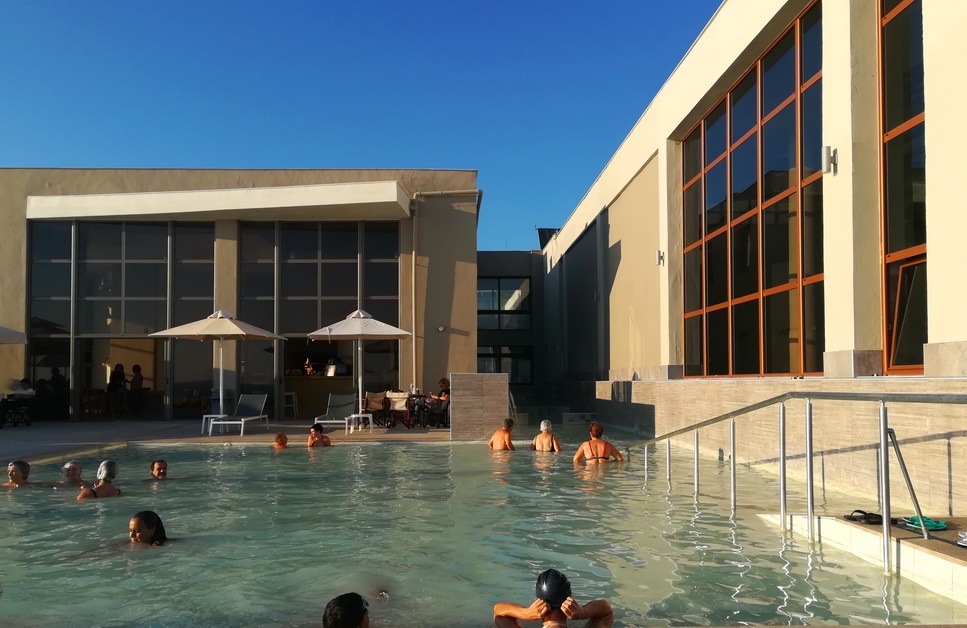
Agia Pareskevi, facing the bay of Thermaikos, is not at all what you expect when you come to Halkidiki. We think of beaches and restaurants, maybe some hiking.
But Agia Pareskevi is a spa town, high on a cliff with its views across the bay all the way to Mt. Olympus. We could smell it before we got out of the car, because the air was so thick with sulfur. You won’t mind just as soon as you see the view though – possibly Halkidiki’s best.
The modern municipal facility is built right at the cliff’s edge, with a large deck for enjoying a snack or a drink. There’s an outdoor pool, and an indoor pool. The water is extraordinary. It’s almost opaque and milky white, saltier than the sea by far. It leaves your skin like velvet. The therapeutic water is rich in minerals benefiting the skeletal system, joints, skin, and addressing other ailments (see a list here). There is also a sauna and hamam for making the most of a relaxing afternoon.
Sani Beach
Sani Beach is the most famous resort destination in Kassandra. This is an exclusive resort complex near the top of the leg, facing the Bay of Thermaikos. Sani Beach offers a range of luxury accommodations, a marina, and the lovely Turtle Beach.
Besides the pristine beach and gorgeous natural setting, Sani is also a prime destination for culture. They hold a famous music festival each summer – coming into its 28th year. They also hold a gourmet festival featuring International and Greek Michelin-starred chefs
Sithonia, Halkidiki
Halkidiki’s middle leg is famous for fabulous beaches, serenity, and luxury. Although it is little farther from Thessaloniki, the lush scenery of Sithonia is worth the extra drive.
Nikiti
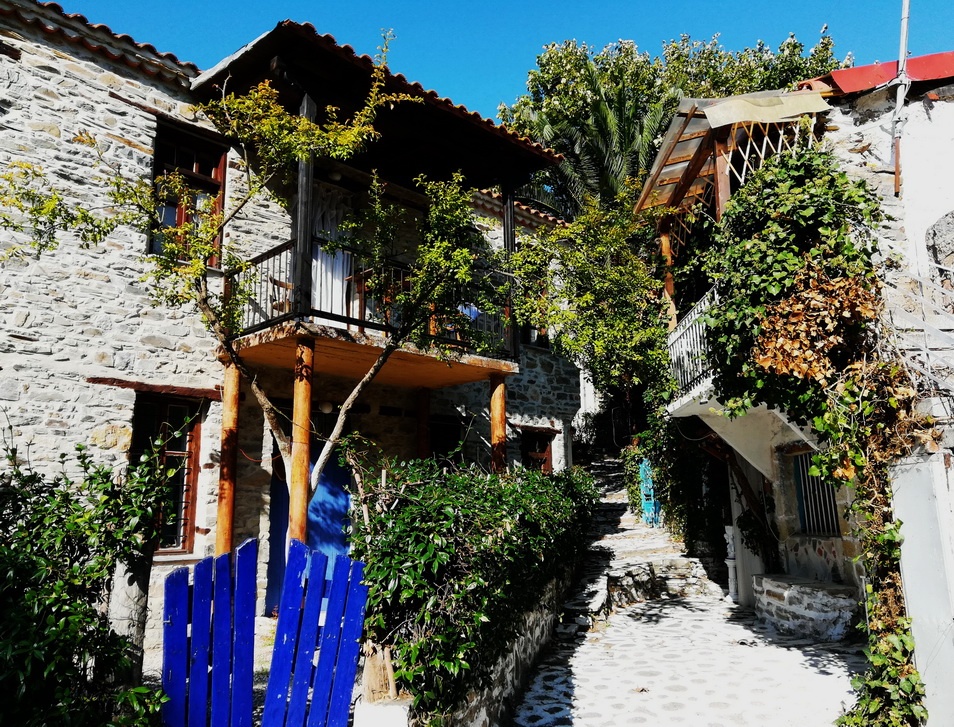
There are actually two Nikitis. There is the newer seaside Nikiti with its fine beach and excellent tourist facilities. Then there is old Nikiti. Seaside Nikiti doesn’t disappoint. But old Nikiti makes a very special stop. This shady stone village that climbs up the wooded hillside was originally a monastic estate.
During the Ottoman era, it grew to become one of the largest villages of Halkidiki. Old Nikiti is full of enchanting traditional homes, with wooden balconies and wood-burning ovens in the courtyards. This is an ideal place to try local specialties at a rustic taverna.
Elia Beach
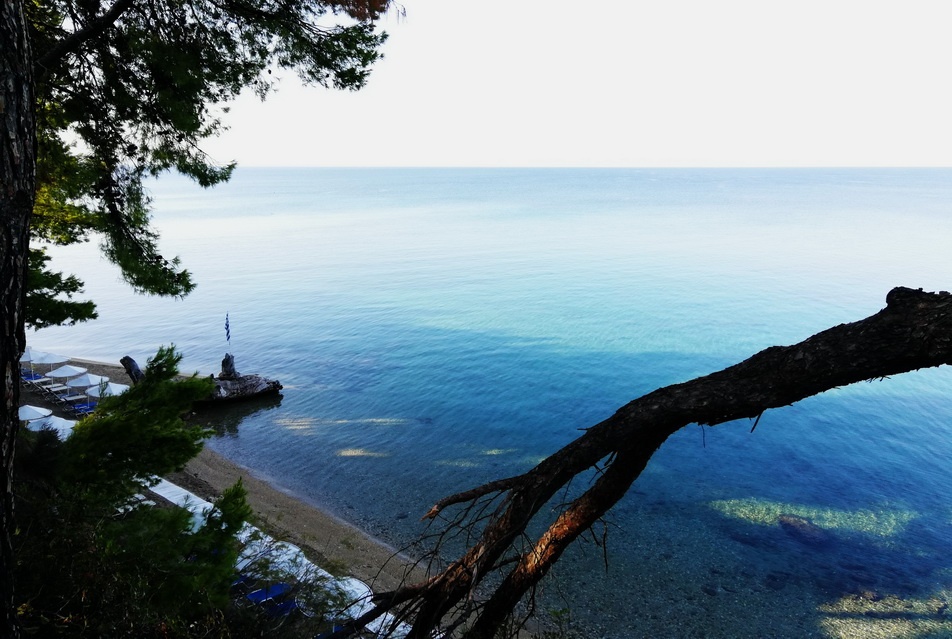
just down from Nikiti is the fabulous Elia beach. Tall pines shade this lovely beach. bordered by dramatic cliffs. The clean pebble beach is pristine, with pure, clear waters.
Acrotel Athena Palace
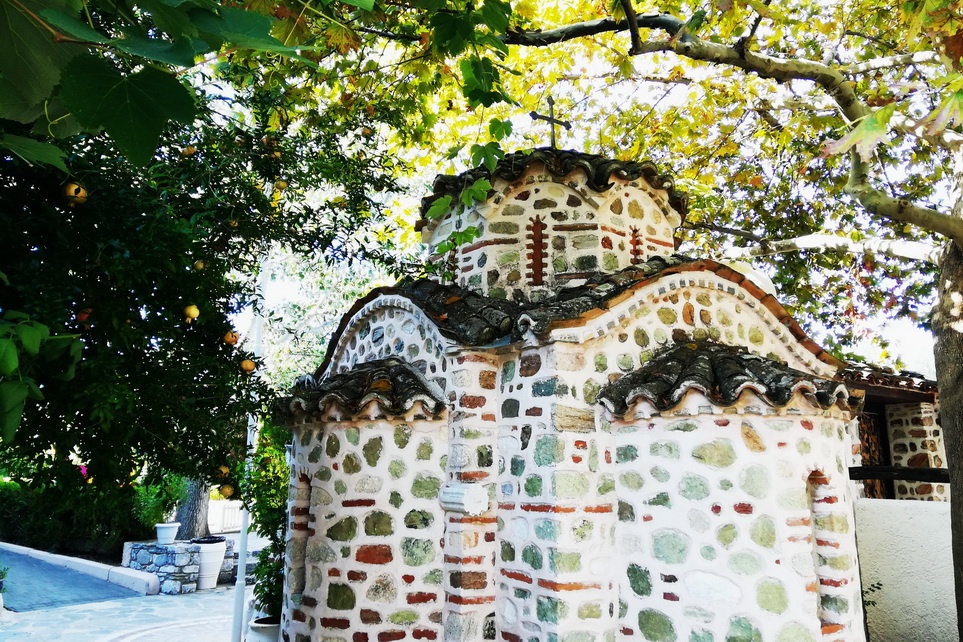
We stayed by Elia Beach at a fantastic all-inclusive five-star resort. I loved the Acrotel Athena Palace. I’m not usually a fan of all-inclusive resorts, because even if they are elegant, they too often lack character. The Acrotel Athena Palace had beautiful, authentic details throughout. Our poolside bungalow had rough stone walls and wooden beams, like the best village architecture. The generous buffets also focused on local specialties are looking for a luxurious and carefree holiday but still want to know you’re in Greece, this is an excellent choice.
Nea Marmaras
Another town – like Nea Fokea and Potidea – that was settled by refugees from Asia Minor in the 1920’s. In fact, a replica of the boat “Santala” floats in the harbor of Nea Marmaras. This is one of the more cosmopolitan towns of Sithonia.
Porto Carras
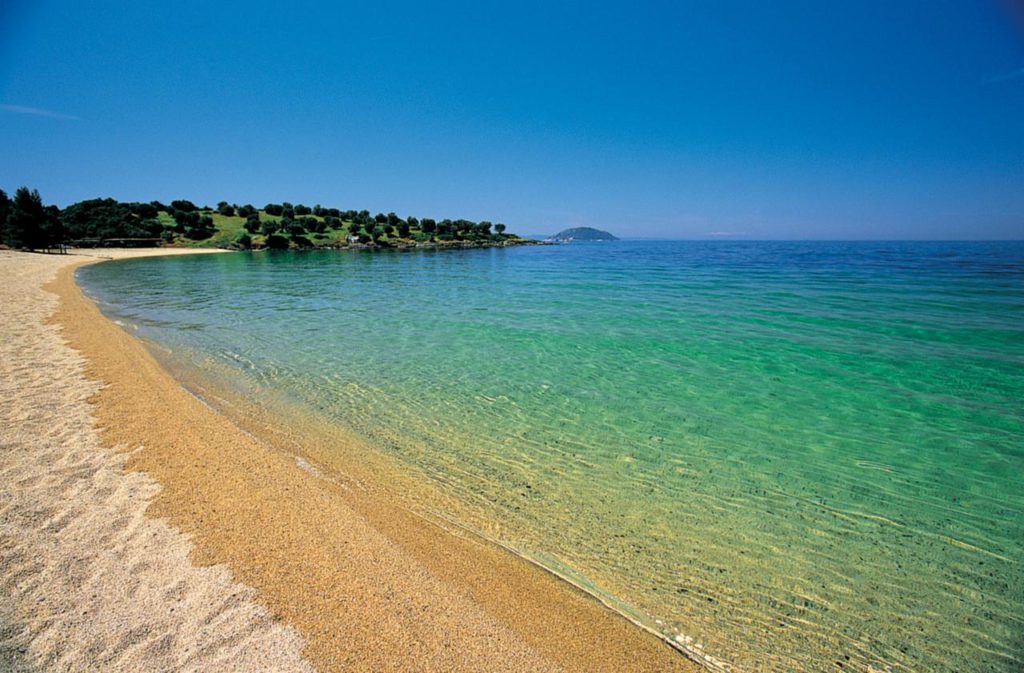
One of the most famous resorts of all Greece is near Nea Marmaras. Porto Carras features some of the Mediterranean’s best golfing – 18 holes on a 77 hectare course. It’s also a serious wine tourism destination, with Domaine Porto Carras producing some of Greece’s finest wines. Spas, equestrian facilities, exquisite dining, and even a casino ensure that whatever type of holiday you like, Porto Carras can provide the ideal experience.
Toroni
Even among all the beautiful beaches Halkidiki has to offer, Toroni really stands out. Toroni is nearly at the end of the leg. The beach curves to embrace the Bay of Toroni, with a tiny island on one side and a rocky promontory shielding the bay on the other. The water is beautiful and there is some excellent diving here, with lots to see. Toroni has been inhabited since neolithic times, and had an ancient settlement. There are ruins of the ancient harbor just below the surface.
Porto Koufo
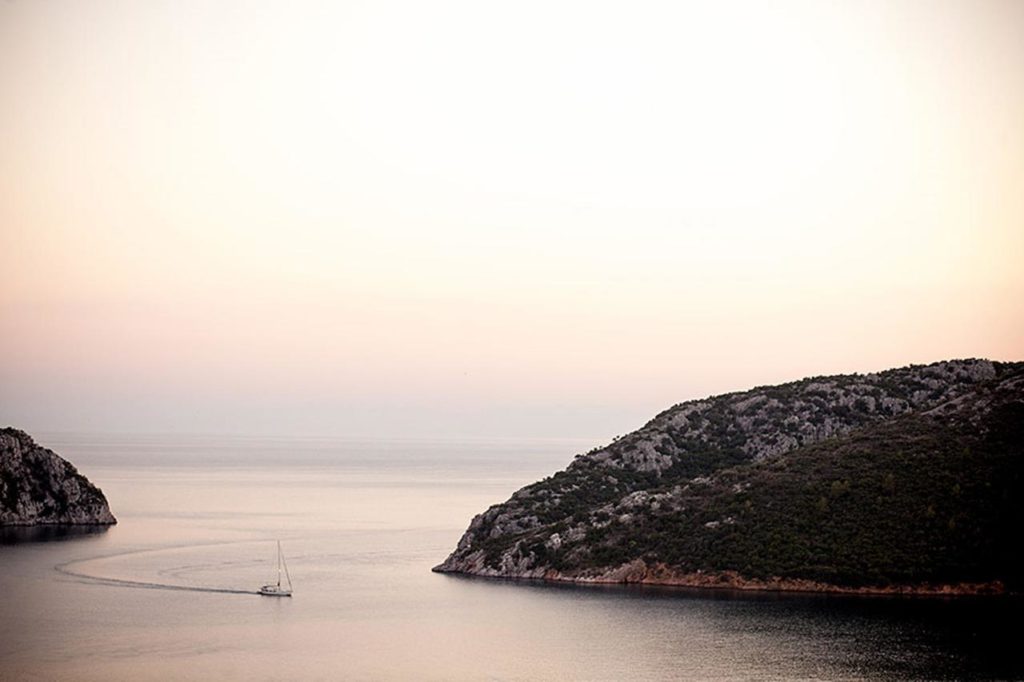
Just past Toroni is another sparkling turquoise bay. This deep bay is nearly completely enclosed. The scenery is dramatic, with rocky cliffs and caves. This is a fine hiking destination. There’s a 4 km circular route to the summit of Kapros. From here, you can admire the bay.
Porto Koufo is one of Halkidiki’s most dramatic areas. Cape Kartalia, Sithonia’s southernmost cape, has rocky cliffs over 100 meters high. The bay of Porto Koufo is the deepest natural harbor of Greece.
There are excellent places to stay in Porto Koufo, such as the elegant Porto Koufo resort. With its well-appointed apartments, its a particularly good choice for families and groups of friends.
Kalamitsi
Thing get a little wilder at Kalamitsi. At the tip of the foot, Kalamitsi faces out into the open Aegean. This laid-back beach community has three excellent sandy beaches. In addition to the main beach, there’s the beach that belongs to the camping and also a nude beach. The full-service camping is a popular destination, and a very fun alternative to a hotel.
Sarti
Working our way up the eastern coast of the leg, on the Bay of Mt. Athos, we come to Sarti. This is one of the more popular destinations in Sithonia. Along 3 kilometers of coastline are beautiful beaches, tavernas and cafes. There are also quieter, remote areas, so you can find exactly what you want. The beaches are gorgeous.
Karvourotrypes Beach
Just north of Sarti is the sublime Karvorotrypes Beach. Karvourotrypes has shallow, clear green waters, silky sands, and great white rocks. You can see Mt. Olympus on the horizon in the distance.
Vouvourou
Vouvourou with its dreamy name is a fantasy beach destination. There are soft sandy beaches, the secluded Karidi cove, the crystal lagoon Livari, and nine tiny islands. Vouvourou also has a magnificent coral reef that divers love.
Vouvourou is also fine destination for kayaking. You can explore the dreamy lagoon and the tiny sandy islands. There is a hidden bay, too – it’s even called “hidden” – Kriftos.
A complete guide to Vourvourou: Vourourou Beach, Sithonia, Halkidiki
Eastern Halkidiki
This quiet side of Halkidiki is popular with people from the region. Because there are fewer tourists, you’ll find tavernas catering to locals. There is excellent fresh fish. The sandy beaches that face the open Aegean are also less crowded. This is also the part of Halkidiki with one of Northern Greece’s most interesting archaeological destinations.
Ancient Stagira
Ancient Stagira was the birthplace of the Philosopher Aristotle. It was originally a colony of the island Andros. They came for the wealth of timber, to build their fleets, and minerals – especially gold – to fund their campaigns.
The city was destroyed by Phillip of Macedon when he conquered the region. But Aristotle was tutor to Phillip’s son – Alexander the Great. Phillip rebuilt Stagira, a mark of his esteem.
This is one of the most lush and exciting archaeological sites you are apt to visit. The views are stellar. And there is a great sense of discovery coming upon the ruins amidst the grasses and trees.
Ierissos
Right next to the site of Ancient Stagira, Ierissos is one of the busiest towns of Eastern Halkidiki. Ierissos was once known for shipbuilding, and had one of the largest shipyards of Greece. Visit Karnagio – the old ship yards, on the was from Ierissos to Nea Roda. There are also Byazntine ruins of a castle and a church. There is also an aquarium in Ierissos.
New Stagira
New Stagira, besides having fantastic views, has the Park of Aristotle. Here, you can experience Aristotle’s observations about physics and perception through interactive installations.
Nea Roda
At the narrowest part of the neck of the Athos peninsula, Nea Roda was the largest of the settlement of refugees from Asia Minor. Today, the village is popular for its long sandy beach and excellent seafood tavernas.
The Canal of Xerxes
Just as there is a canal at Potidea, there was once a canal here, too. It was built in the 5th century BC by Xerxes, when the Persians briefly held northern Greece. The canal has since filled with sediment, but its outlines can still be seen.
Central Halkidiki
Central Halkidiki is densely forested, with Mt. Holomondas in the center. Because of the architecture and the mountainous landscape, it’s a completely different mood here. As you drive through, you’ll see monuments from the Greek war of independence. The information is in English too, and you may be surprised to learn of Halkidiki’s importance to the history of Modern Greece.
Polygiros
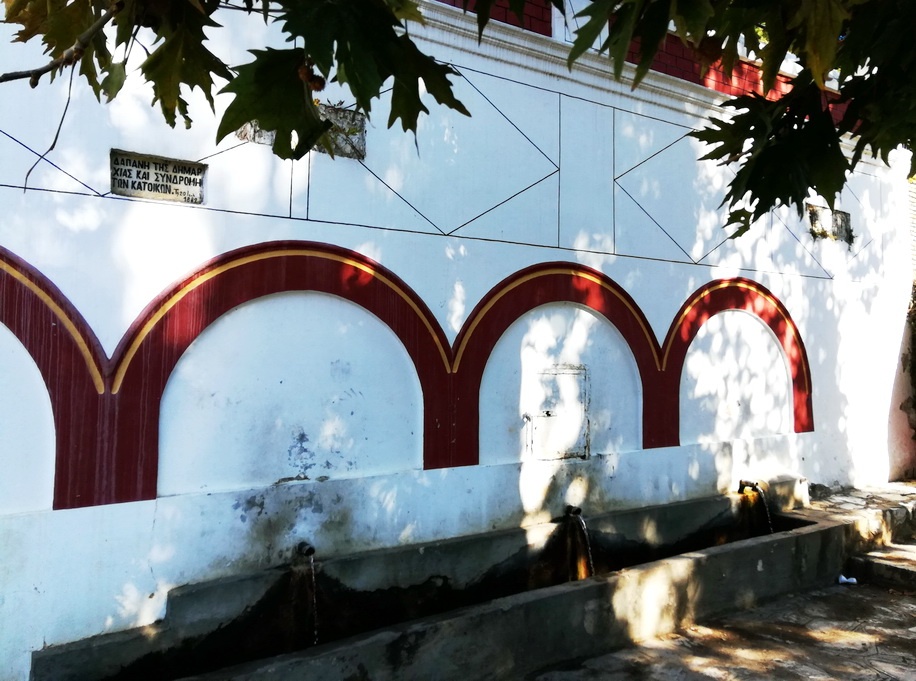
Polygiros, the capital, is a lovely town. Stop here for lunch – we dined at Six Springs (Exi Vrysses”), in the park in the center of town. The mood was cheerful at the family style restaurant, and the food was excellent.
Arnea
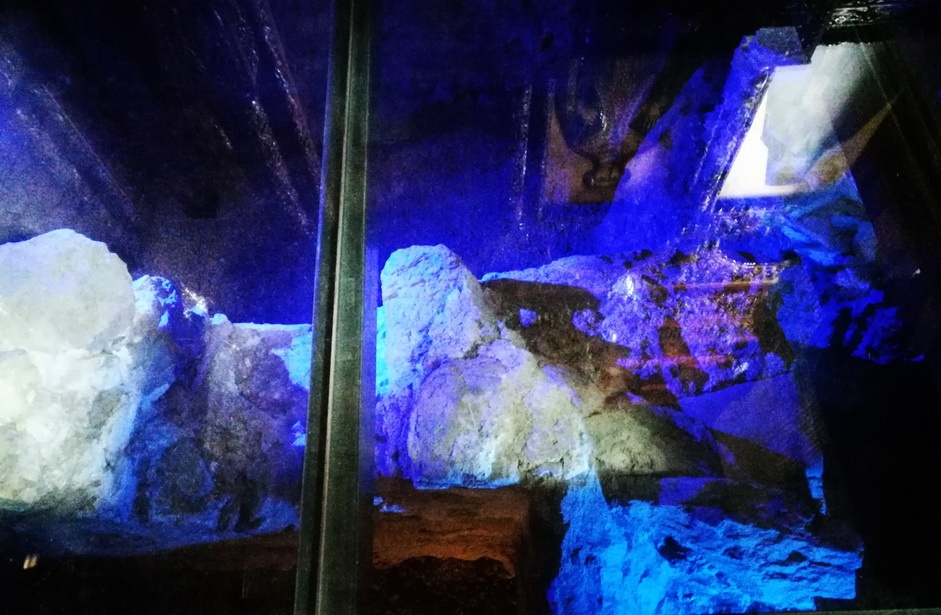
A picturesque mountainous town of traditional stone architecture, Arnea makes an excellent stop in summer and winter. Cold sweet water flows from a plane tree in the central square, and there is honey in abundance. The pine honey of Halkidiki is excellent. There is also a magnificent church here. The 19th-century Church of Agios Stefanos is very unusual. During a reconstruction after a fire, Byzantine ruins were found beneath. Now, much of the floor of the church is glass, so you can see the monuments beneath.
The Halkidiki Experience – A Destination for All Seasons
We really loved having the complete Halkidiki experience. With the mild temperatures of Greece, the beaches are actually swimmable sometimes as late as November. In the cooler months, there are the mountain pleasures, beach strolls, culture – like Ancient Stagira, and that fantastic thermal spa. Of course, you can dine on hearty and authentic mountain cuisine by the slopes of Mt. Holomondas, or enjoy the best of winter’s fresh catch from the sea.

